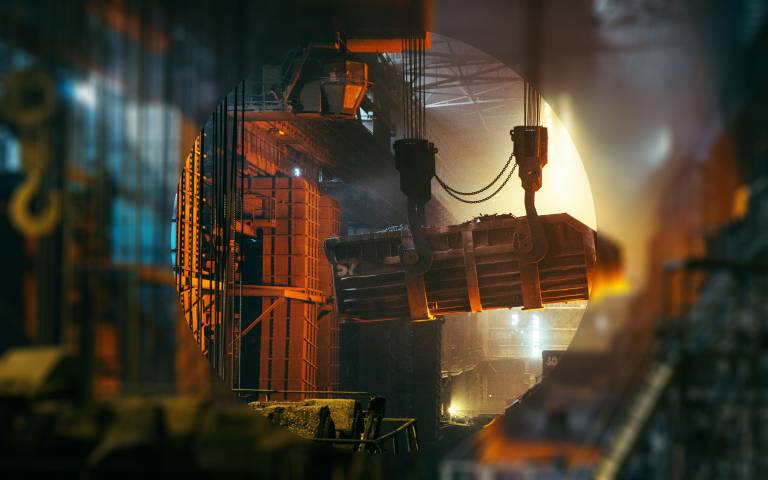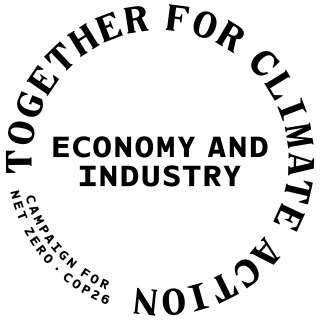Remaking steel for a net zero carbon circular economy
7 September 2021

Climate action’s goal to deliver ‘net-zero’ emissions will require joined-up thinking across different parts of the economy and society. The circular economy – an economy that is designing out waste and emissions, keeps products and materials in use, and regenerates ecosystems – is a key opportunity to reduce carbon emissions through transforming industry and final demand for their products via novel design. Emissions resulting from the manufacture, use and disposal of industrial products will need to be addressed. A key measure to tackle this is to enable circular loops of products and the materials they use.
Steel is among the top three carbon-intensive products worldwide. Steel is widely used in key sectors including infrastructures, construction, and vehicle manufacturing but is also instrumental in renewable energy technologies and for enabling trade. Cargo shipping, based on steel, connects the world of production wherever it occurs with items of our daily lives; refrigerators and washing machines made of steel elsewhere are delivered to private households. It is hard to imagine how development in low-income countries could take place without greater use of steel.
Fortunately, delivering ‘net-zero’ steel does not imply phasing out production or require de-industrialisation. Steel has unique properties of durability and recyclability; light-weight steel structures can help to significantly reduce use of energy and other resources by the products and processes in which they are used. Remaking the steel industry, including its methods of production, the development and use of innovative new products and services that use it, and creating demand for these methods, products, and services, is crucial. The real question, therefore, is as follows:
Can we turn today’s high-carbon sector into tomorrow’s net zero champion?...
We propose the vision of an almost infinite re-utilisation of steel, which is supported by the low-carbon advantages of the secondary steel route. Recycled steel could save 86% of greenhouse gas (GHG) emissions, 85% of energy, 76% of water pollution, and 40% of water consumption by using the electric arc furnace (EAF) route of steel making, compared to the route of primary extraction and blast furnaces (BF). A main difference between EAF and BF is the latter needing energy-intensive processes of iron ore extraction and coke both as a reductant and as a source of thermal energy, while EAF uses scrap and electricity benefitting from renewable energy supply. In line with the UK Climate Change Committee recommendation of setting targets for ore-based steel-making to reach near-zero emissions by 2035, the newly established UKRI Centre on Circular Metals (CircMet) has the mission to make the UK the first country in the world to realise a fully circular use of metals.
Scrap steel is abundantly available in the UK. It’s just that it’s mainly exported and typically downcycled. In the UK, around 11-12 Mt of scrap are generated every year, which is in principle sufficient to meet domestic demand, except that three quarters leaves the UK each year. Retention of scrap could help achieve UK net zero goals if it was designated a strategic asset. This would also require considerable investment in UK scrap sorting capacity and EAF infrastructure.
Recycling and re-use of steel will reduce the annual $7.3bn import bill for iron and steel, supporting areas like power generation, sustainable construction and refurbishments, e-mobility, and engineering, as well as strengthening resilience for the around 70,000 jobs in steel industry. Remaking steel will also trigger innovation in interconnected industrial sectors, estimated to comprise over 11,000 companies with 230,000 employees and contributing £200Bn of UK’s GDP that are underpinned by metals. Remaking steel industry around high-quality and new design based on scrap will also help to address the carbon emissions associated with the current production of imported steel goods.
…Yes, although there remain barriers to overcome
Key barriers are in the domain of economics, business, and technology:
- Pricing better. Prices for iron ore, steel, and scrap need an environmental overhaul. International prices have doubled over the last twelve months according to IMF analysis. However, volatility has been the dominant feature over decades. Future price expectations are highly uncertain. Scrap prices typically follow the commodity prices, but production costs (especially in the case of EAF) are highly dependent on electricity prices, which in the UK are significantly higher than for many of our European competitors. Possible policies include a carbon tax applied to the whole supply chain, which also applies to imported steel; other options include carbon-risk based accounting and business rates and a properly managed emissions trading system. Financial incentives for investments into sorting and up-cycling facilities will be key. Making electricity prices competitive in line with the decreasing costs of renewable energy will be a key challenge for UK industrial policy, potentially benefitting from electricity market reforms.
- Supply chain innovation. Scrap producers, the steel industry, and downstream users need a better alignment. Making high quality recycled steel requires better standards for sorting and monitoring along value chains. Material efficiency savings along supply chains are available but require important changes in the design and use of steel products. Users and producers need to collaborate to develop roadmaps for future low-carbon steel products in sectors that use it; activities on remanufacturing, re-use, novel design and business model innovations such as leasing steel could start in the UK and develop internationally over time.
- Demand stimulation. The Mission Possible Partnership and SteelZero of the Climate Group are seeking to establish green buyer alliances which could establish lead markets for new low-carbon steel. Public procurement of low-carbon steel to be used in public works and infrastructure can also create certainty that there is a market for producers, encouraging them to invest. In fact, the Ministry of Defence recently announced plans to purchase and nationalise the Forgemasters EAF site for reasons of material security. London’s Metal Exchange could also play a role through a green premium in stock shares and low carbon steel.
- Technological challenges. Increased traceability of steel products and better sorting and monitoring processes for scrap steel can ensure high quality secondary steel that can meet carbon targets while ensuring high quality products. Over time, new products and systems will need to incorporate alloys, components, and semi-finished and consumer products with enhanced design for circularity. An agency for circular metals could be established to foster maintenance and repair of capital goods and promote steel reuse in construction and infrastructures (e.g., reuse of steel structural beams).
At a global level, our UCL macro-economic model ENGAGE suggests international advantages from transitioning towards a circular approach using secondary steel. Developing countries will benefit from lower costs to set up infrastructures, although some countries reliant on extraction of primary ores will need transition strategies to moderate the impact on their economies. Large steel producers and users such as China will have significant amounts of scrap made available in the coming years and decades; they are likely to benefit even alongside a decrease in primary production if capacity is redirected from primary to secondary steel systems. The IEA expects Chinese secondary steel production to increase from about 10% of China’s production today to around 45% by 2050.
Upscaling UK scrap usage by 40-50% is possible in the short term. Empowering the existing capacity to double the secondary steel route in the UK with investments should be feasible. Policies will be useful to fix price distortions, establish industry collaboration on innovation and an agency for circular metals, and set new standards to increase the quality of secondary metals; a roadmap to deliver zero carbon steel via a circular economy will help to remake steel industry in the UK and internationally. Circular metals are key to a green industrial revolution and to the UK’s ambitions to double resource productivity and deliver net zero by 2050.
 Close
Close


